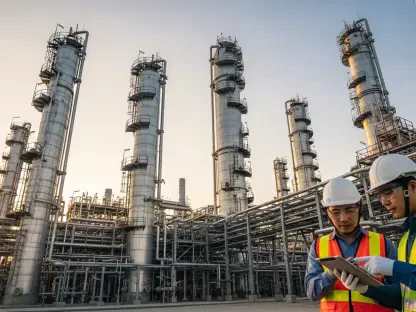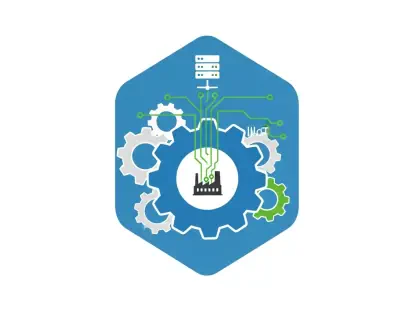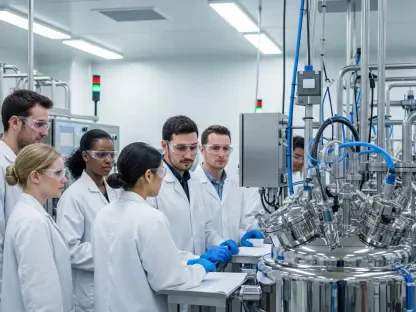Today, we’re joined by Kwame Zaire, a manufacturing expert with a strong background in electronics, equipment, and production management. He’s well-regarded for his insights into predictive maintenance, quality, and safety. With Europe’s chemical industry facing significant sustainability challenges, Kwame’s expertise is particularly relevant as we delve into strategies for defossilizing this critical sector.
Can you explain the current status of the European chemical industry and the challenges it faces?
The European chemical industry, once a global leader, is now encountering numerous challenges. It faces intense global competition, particularly from China and the US, which have become dominant players in both production and innovation. Rising energy costs and stringent regulatory requirements add to the pressures, leading to signs of declining competitiveness and deindustrialization within the sector. The industry’s heavy dependence on fossil fuels for raw materials further complicates efforts to control its carbon footprint and transition to a more sustainable model.
How has global competition impacted Europe’s chemical industry?
Global competition has significantly impacted Europe’s chemical industry by highlighting the disparities in production efficiency, cost structures, and innovation capacities. Competitors, especially from China and the US, benefit from lower energy costs, more aggressive policies supporting industrial growth, and substantial investments in R&D. This scenario has created a tough environment for European chemical companies to remain competitive, leading to a loss in market share and a notable decline in leadership in patents and new technologies.
What are the primary reasons for the decline in Europe’s competitiveness in the chemical sector?
Several factors contribute to this decline. Firstly, high energy prices in Europe make manufacturing more expensive compared to regions with cheaper energy sources. Additionally, the regulatory environment, while crucial for safety and environmental standards, often imposes heavy compliance costs and slows innovation. Another key issue is the reliance on imported raw materials, which adds to the vulnerability of the supply chain and increases production costs.
To what extent does the industry rely on fossil fuels for raw materials?
The chemical industry in Europe relies heavily on fossil fuels, with over 90% of its raw materials derived from non-renewable sources. This dependency not only makes the industry susceptible to fluctuations in fossil fuel markets but also significantly contributes to its carbon emissions, posing a challenge for the region’s environmental and sustainability goals.
How does this reliance on fossil fuels affect the industry’s carbon footprint and overall sustainability?
The reliance on fossil fuels has a profound impact on the industry’s carbon footprint. It accounts for a significant portion of greenhouse gas emissions, undermining efforts to achieve climate neutrality. This dependency also limits the industry’s flexibility in adapting to greener practices and affects its long-term sustainability, as the transition to renewable resources becomes increasingly urgent in the face of environmental regulations and societal expectations.
What are the signs of deindustrialization within the EU chemical industry?
Signs of deindustrialization in the EU’s chemical industry include reduced output, lower investment in new technologies, and the relocation of manufacturing units to regions with more favorable economic conditions. There has also been a noticeable decline in patent filings and innovation, illustrating a waning competitive edge. Additionally, job losses and the closure of plants further signal this troubling trend.
What does “defossilizing” the chemical industry entail?
Defossilizing the chemical industry involves transitioning away from fossil fuel-based raw materials toward renewable carbon sources. This means adopting alternative feedstocks such as biomass, carbon capture and utilization (CCU), and recycling materials. The goal is to reduce carbon emissions, diversify raw material sources, and ultimately create a more sustainable and resilient industry.
What renewable carbon sources can the industry transition to?
The industry can transition to several renewable carbon sources, including biomass from agricultural and forestry residues, and carbon obtained from recycled materials. Additionally, carbon capture and utilization technologies can convert CO2 emissions into valuable chemicals and materials. Each of these sources offers different benefits and challenges, but collectively, they represent a pathway to reducing reliance on fossil fuels.
Why is transitioning to renewable carbon sources considered not just an environmental necessity but also a strategic move?
Transitioning to renewable carbon sources is strategically important because it enhances the industry’s resilience and reduces vulnerability to fossil fuel market dynamics. It can also drive innovation, open up new markets for sustainable products, and align with broader regulatory trends favoring environmental sustainability. Furthermore, it positions Europe as a leader in green technologies, potentially providing economic benefits and job opportunities.
What barriers are currently hindering progress toward renewable carbon use?
Several barriers exist, including regulatory hurdles, the slow expansion of renewable energy infrastructure, and insufficient market demand for sustainable products. There is also the challenge of scaling up new technologies from pilot to commercial scale, which requires significant investment and favorable policy support. Additionally, the high cost of renewable raw materials compared to fossil-based alternatives can be a deterrent to widespread adoption.
Can you briefly describe the ten policy proposals made by the Renewable Carbon Initiative (RCI)?
The Renewable Carbon Initiative outlines ten key policy proposals aimed at accelerating the transition to renewable carbon. These include setting mandatory targets for renewable carbon use in chemicals and materials, adapting existing regulations like the EU Emission Trading System, ensuring sustainable access to renewable carbon feedstocks, fostering innovation, and creating favorable conditions for scaling up technologies. The proposals also emphasize the need to balance regulations between energy and material uses to maximize synergies and enhance the availability of affordable renewable energy.
How were these policy proposals developed, and who was involved in their creation?
These policy proposals were developed collaboratively by experts from the nova-Institute and members of the Renewable Carbon Initiative. The process involved extensive research, stakeholder consultations, and analyses of current industry challenges and opportunities. The aim was to create a comprehensive framework that addresses the multifaceted nature of the transition to renewable carbon and aligns with broader EU policy goals.
What key elements are included in the vision for defossilization provided by RCI?
The vision for defossilization by the RCI includes a high-level commitment to transitioning the chemical industry to renewable carbon sources. Key elements involve establishing mandatory targets for renewable carbon use, ensuring sustainable access to these materials, and incentivizing market demand through regulatory adaptations. The vision also highlights the need for continuous innovation, creating a supportive policy environment, and fostering collaboration across the value chain to achieve these goals.
Why is an overarching commitment to defossilization essential for Europe’s policy framework?
An overarching commitment to defossilization is crucial as it provides a clear direction and framework for all subsequent policies and actions. This commitment signals to industry stakeholders, investors, and the global community that Europe is dedicated to achieving sustainability. It sets the stage for coherent and coordinated policy initiatives, reducing uncertainties and fostering a supportive environment for long-term investments in renewable technologies.
How can mandatory targets for renewable carbon in chemicals and materials drive market demand?
Mandatory targets create a guaranteed market for renewable carbon sources, encouraging companies to invest in and adopt these materials. This demand-pull approach stimulates the supply chain, driving innovation and reducing costs through economies of scale. It also provides the necessary market signals for investors to fund developments in renewable carbon technologies and infrastructure, accelerating the transition.
What existing regulations might need to be adapted to implement these mandatory targets?
Existing regulations such as the Packaging and Packaging Waste Regulation (PPWR), the End-of-Life of Vehicles Regulation (ELVR), and the Ecodesign for Sustainable Products Regulation (ESPR) may need to be adapted. These adaptations would involve integrating renewable carbon use requirements and ensuring these regulations work synergistically with the mandatory targets. Additionally, the EU Emission Trading System might need revisions, or alternatively, the establishment of a new European Carbon Utilization Trading System (CUTS) could be considered to support this transition.
How would an adaptation of the EU Emission Trading System or a new European Carbon Utilization Trading System (CUTS) contribute to this initiative?
Adapting the EU Emission Trading System or creating a new European Carbon Utilization Trading System (CUTS) would provide financial incentives for companies to reduce emissions and invest in renewable carbon technologies. These systems would put a price on carbon emissions, making fossil-based raw materials more expensive and renewable options more attractive. They would also generate funds that could be reinvested into developing and scaling up renewable carbon projects, thereby accelerating the transition.
What specific measures does RCI propose to ensure sustainable access to renewable carbon feedstocks?
RCI proposes several measures, including facilitating the use of more waste as feedstock, ensuring local access to biomass from agriculture and forestry, and advancing carbon capture and utilization technologies. RCI also emphasizes the importance of supporting international trade of renewable carbon feedstocks to diversify sources and enhance supply security. These measures collectively aim to create a stable and sustainable supply of renewable carbon for the industry.
Can you elaborate on how local access to biomass from agriculture and forestry can be secured?
Securing local access to biomass requires supportive agricultural and forestry policies that encourage sustainable production practices. This includes incentives for farmers and foresters to supply biomass, investments in infrastructure for harvesting and transporting these materials, and ensuring that biomass production does not compete with food production. Establishing partnerships between industries and local biomass suppliers can also create reliable supply chains and promote regional economic development.
What role does international trade of renewable carbon feedstocks play in this transition?
International trade is crucial for diversifying the sources of renewable carbon feedstocks and ensuring supply security. It allows regions with abundant renewable resources to export to those with higher demand, balancing global supply and demand dynamics. This international cooperation can also accelerate the development of global standards and best practices for sustainable biomass production and carbon capture, fostering a more integrated and resilient market.
How can regulations be balanced between energy and material uses to create synergies?
Balancing regulations requires a holistic approach that considers the interdependencies between energy and material uses. This involves creating policies that do not favor one use over another but instead promote the optimal use of resources across sectors. For example, policies could encourage the use of biomass in both energy production and material manufacturing, ensuring that renewable carbon feedstocks are used efficiently and sustainably to maximize their environmental and economic benefits.
Why is the availability of affordable renewable energy crucial for defossilization targets?
Affordable renewable energy is essential because it directly impacts the cost-competitiveness of renewable carbon technologies. The production and processing of renewable carbon feedstocks often require significant amounts of energy, so having access to low-cost renewable energy reduces operational costs and makes these technologies more viable. It also supports broader sustainability goals by ensuring that the energy used in these processes is clean and renewable.
How can favorable conditions be created to align renewable energy availability with defossilization goals?
Creating favorable conditions involves policy measures such as subsidies, tax incentives, and long-term contracts for renewable energy. Investments in renewable energy infrastructure, like wind and solar farms, and facilitating grid integration are also important. Additionally, aligning energy policies with industrial needs ensures that renewable energy is reliably available where and when it’s needed, supporting the overall defossilization strategy.
What is the “implementation gap” you mentioned, and why is it significant?
The implementation gap refers to the disconnect between innovative ideas and their large-scale application. While many renewable carbon technologies exist, they often face barriers in scaling from pilot projects to full commercial operation. This gap is significant because closing it is essential for achieving meaningful impact. Addressing it involves reducing regulatory hurdles, securing financing, and creating market conditions that support the adoption and diffusion of these technologies.
How will addressing the implementation gap help in transitioning from innovation to scaled products?
Addressing the implementation gap ensures that promising technologies move beyond the lab and pilot stages to become commercially viable solutions. This involves providing support through favorable policies, funding opportunities, and infrastructure development. By enabling these technologies to scale up, they can achieve economies of scale, reduce costs, and become more widely adopted, thus contributing significantly to the transition to renewable carbon sources in the industry.
What economic benefits can Europe expect from pioneering renewable carbon technologies?
Pioneering renewable carbon technologies can drive significant economic benefits, including job creation in new and emerging industries, increased investments in R&D, and the establishment of Europe as a global leader in sustainable chemical production. These technologies can open up new markets for eco-friendly products, enhance competitiveness, and attract international investments. Furthermore, reducing dependence on fossil fuels can lead to greater energy security and price stability.
How do renewable carbon technologies contribute to Europe’s climate neutrality ambitions?
Renewable carbon technologies are pivotal in reducing greenhouse gas emissions, a core component of Europe’s climate neutrality goals. By replacing fossil-based raw materials with renewable options, these technologies help cut carbon emissions throughout the lifecycle of chemicals and materials. They also support the circular economy by utilizing waste and captured carbon, significantly reducing the industry’s overall carbon footprint and aligning with broader climate targets.
How can a comprehensive and reliable framework support the transformation of the chemicals and materials sector?
A comprehensive framework provides clear guidelines, incentives, and support mechanisms for the industry’s transformation. This includes robust policy measures, financial incentives, and regulatory clarity. It also involves fostering collaboration between stakeholders, including governments, industry players, and research institutions, to drive innovation and implementation. Such a framework ensures that all efforts are aligned, resources are optimized, and progress towards defossilization goals is measurable and sustained.
Do you have any advice for our readers?
For those involved in the chemical industry, embracing innovation and being proactive about sustainability can offer significant competitive advantages. Engaging with policy developments, investing in renewable technologies, and fostering collaborations can pave the way for a successful transition. For consumers and stakeholders, supporting sustainable products and advocating for responsible policies can drive demand and catalyze industry-wide changes. Ultimately, every effort counts in building a more resilient and sustainable future.









